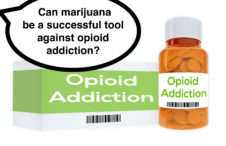There’s a surprisingly effective weapon again opioid deaths. But will we use it?
Cannabis may slow America’s plague of opioid deaths
The devastating toll of deaths from opioid addiction keeps growing. All round the country – in the heartland, on the coasts, in cities and rural areas, death rates from overdoses of heroin or prescription opioid pain medications like OxyContin are shocking.
At the beginning of this year – January, 2016 – we examined the effect of medical marijuana on the opioid addiction crisis in America. For a link to the previous blog click here. As the year draws to an end, it’s time to look at new data and update our understanding of this issue.
The opioid addiction crisis
Americans seeking relief from chronic pain turn to their doctors for help. Pharmaceutical companies for years aggressively promoted and pushed opioid prescription drugs like OxyContin to doctors, before understanding the dangers of this class of drugs. Although opiates occur naturally in the opium poppy, natural opiates provide short-term pain relief. Opioid drugs were developed to provide long-lasting relief.
However, independent studies have since shown that they are not effective for long-term use. But they are extremely addictive. This addiction danger was overlooked, downplayed or ignored as these drugs were prescribed more and more, leading countless pain suffers to become inadvertently addicted. They are easy to get, and have become extremely popular for non-medical street use for getting high, sometimes surpassing heroin in popularity. In many cases, people using prescription painkillers move on to heroin use. Both prescription painkillers and heroin are easily available on the street, but heroin is cheaper.
Marijuana as a tool to fight opioid addiction deaths
In 2015, a JAMA study found that prescription painkiller deaths dropped in states that allowed both medical marijuana and dispensaries. The study showed that states with laws that allow medical marijuana dispensaries saw a relative reduction in opioid overdose deaths and addiction treatment admissions.
A paper from the RAND Corporation concurred, concluding, “Our findings suggest that providing broader access to medical marijuana may have the potential benefit of reducing abuse of highly addictive painkillers.”
Now that nearly half of all US states allow some kind of marijuana use, there should be more data to draw from. The NIH (National Institutes of Health)’s NIDA division (National Institute on Drug Abuse) has supported research which looked at both positive and negative effects of access to marijuana.
Three economists from the RAND Corporation studied three different medical marijuana policies from different parts of the country. Although the policies differed, there was one striking result that stood out: Localities with access to legal marijuana dispensaries were associated with lower rates of dependence on prescription opioids, and also with lower rates of deaths from opioid overdose, than prior trends would have forecast – up to 31% lower. Reductions in admissions for treatment of opioid addiction went down as much as 35%. The researchers found that the longer the legal marijuana dispensaries were in place, the more the rate of opioid-related deaths dropped.
The study also showed that these localities showed higher rates of recreational marijuana use.
Why the drop in opioid-related deaths and admissions for treatment? The researchers speculated that some patients with chronic pain find that marijuana provides relief with more acceptable side effects than opioids. Also, recreational users may find marijuana simpler, easier and less risky than opioids.
What are the negatives to access to legal marijuana?
There were three main downsides seen to easy access to legal marijuana.
Recreational use of marijuana by adults rises. Treatment admissions for marijuana use and dependence among both adults and underage users rises. And the potency of illegal marijuana tends to rise.
Although these negative findings point to the need for regulations over this industry, marijuana is not physically addictive like tobacco or alcohol. That doesn’t mean that dependence does not happen, but it’s more about psychological dependence and the lure of an easy way to feel better or distraction habit.
Marijuana use among young people is a serious cause for concern, as early use of marijuana may affect the developing brain. What’s more, early use of marijuana may act as a crutch, keeping young people from learning more positive coping mechanisms for stress, boredom and anxiety.
Moving forward
Although these early studies are intriguing, this positive trend may not continue. The regulatory and political landscape around marijuana is changing. Some states have tightened safeguards against abuse, making it more difficult for both doctors to prescribe and for patients to obtain medical marijuana. Some physicians may be spooked by fears of negative effects or complications to their practice. And, marijuana’s popularity as a recreational drug may taint its reputation as a drug with positive value.
More study is needed. In a few years, when new medical marijuana laws in various states can be better evaluated, the data and policies can be reconciled.
How to fight opioid deaths? Maybe we should just take it one toke at a time.
